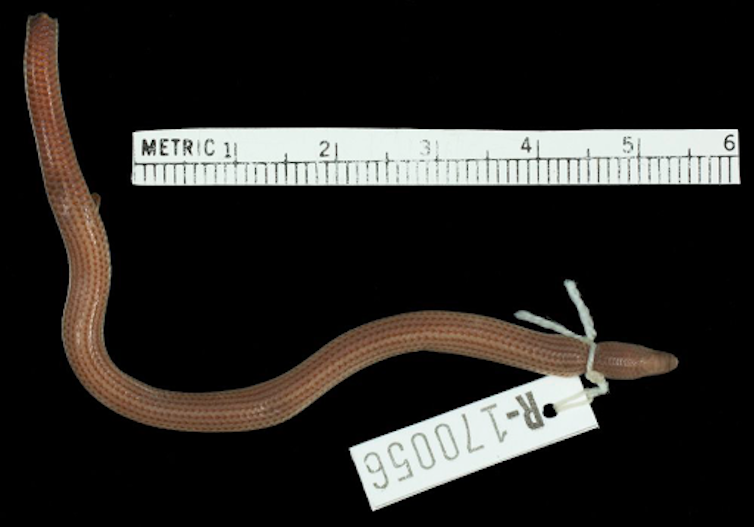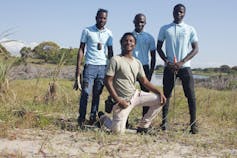Harith Omar Morgadinho Farooq, University of Gothenburg and Allison Perrigo, University of Gothenburg
Every morning the phone buzzes, many times in short succession, as the students send photo after photo of the snakes, frogs and lizards that have been caught in various traps the previous day. We scroll through the images. Again – no Scolecoseps boulengeri. No Proscelotes aenea.
These two burrowing skinks – a type of lizard – were discovered in Lumbo, Northern Mozambique, in the 1920s. During this period, naturalists often used the readily available infrastructure at military bases during the East African Campaign of World War I as base camps for sampling. But then, the war ended and the naturalists stopped collecting at these sites. After that, the two skink species, assumed to be endemic to Mozambique, were not recorded again. Why?
We’re not entirely sure. It is possible, though, that the skink species are still there – they just haven’t been spotted because no one has been looking. This is a sadly common problem. Despite being an exceptional area for biodiversity – with a variety of habitats ranging from tropical savannahs up to highland mountains and down to coastal mangroves – northern Mozambique is severely undersampled, even by African standards. There simply isn’t much data about on the area’s species.
This is partly due to the fact that some places are more accessible than others for various reasons. Parts of the country have been historically inaccessible due to civil war, and other areas are now unreachable due to an ongoing insurgency. Beyond accessibility issues, most field surveys are conducted by international teams, which tend to be more limited by time and require more resources to carry out the work.
Still, these skinks are thought to occur in the sandy soils of easily accessible beaches, in areas that are much more populated now than 100 years ago. Sites such as this make an excellent venue to stage a hunt for long-lost species.
Our project, “Extinct or Shy”, puts the problem of data deficient species in poorly sampled localities in the spotlight. The project asks whether species that haven’t been seen in many decades are actually extinct, or just “shy”. Ambitious students from a university close to the small town where the two burrowing skinks were discovered are leading the hunt for answers.
Africa’s widespread sampling deficiency
As we’ve pointed out in earlier research, species distribution data – or a lack thereof – can have a major bearing on how a country’s Key Biodiversity Areas and protected areas are designated. Even though studies have shown that data deficient species usually end up in threatened categories, they are still not considered when proposing Key Biodiversity Areas, due to the uncertainty of their status.
However, once found or “rediscovered”, well-documented instances of rare species can trigger Key Biodiversity Area status, spearhead conservation efforts and potentially safeguard against extinctions.
The International Union for the Conservation of Nature (IUCN) lists 3,381 African species as “data deficient”; 283 of these may occur in Mozambique. These are the species that we know, or suspect, occur in certain localities, but that lack sufficient data to be assessed according to the rigorous IUCN Assessment Criteria. The missing information may consist of precise localities, the species’ ecology, or population trends, for example.

That’s why our “Extinct or shy?” team is hard at work to locate the elusive skinks. Four students from Lúrio University – Abdulrabe Jamal, Ali Puruleia, Iassine Amade, and Wilson Monia – work alongside collaborators Cristóvão Nanvonamuquitxo and Yasalde Massigue. They are checking the traps daily for an entire year, taking tissue samples and saving vouchers (preserved specimens) for natural history collections. The project will continue through April 2022.
In the process they are not only gathering the data necessary to reassess the conservation status of the skinks; they are also amassing an extensive understanding of the other reptiles and amphibians that occur in the region.
There are two main scenarios for each species in this project. If the species is found, its habitat could be protected via implementation of Key Biodiversity Area status or conservation initiatives. If we don’t find the species, it may already be extinct, or may exist in such small numbers that it may soon go extinct without proper intervention.
If these skinks show up again, this time it will be Mozambican researchers who find them and co-write the paper to describe the finding. This is significant because they will be describing the biodiversity of their own country and strengthening locally held taxonomic expertise. It is also extremely practical.
Local universities can lead the way
Mozambique has 11 accredited universities, spread out across the country. Several of them have multiple, distributed campuses offering natural sciences-related curricula. These institutions could lead initiatives to provide baseline information on poorly known species. That is why we’ve partnered with our Lúrio University colleagues on this project.
Many data deficient species are not easy to find, and will therefore require lengthy field experiments to collect information. This could be arranged between supervisors and students at local universities by equipping them to carry out field studies in adjacent areas, with support from international experts as necessary.

Issues remain with this system. Mozambique lacks even simple field guides for major groups, including mammals, birds, amphibians and reptiles. Field guides for Eastern and Southern Africa routinely exclude northern portions of the poorly documented country, where taxonomic expertise is rarely held by Mozambican nationals.
Inclusive research
For this reason, technology plays a key role in “Extinct or Shy”. Although one of us, Harith, is originally from Mozambique, he now depends on regular connection, usually via WhatsApp, with the students in the field. From Sweden, where we’re both based at the Gothenburg Global Biodiversity Centre, we can identify the specimens in real time and also provide general project guidance.
Read more: Tracking science: a way to include more people in producing knowledge
After the sampling is complete, the whole team will meet to analyse the data and write up our findings together. We hope that eventually the students will use both their field work skills and experience in the scientific process to lead their own research and document Mozambique’s wonderful biodiversity.
Harith Omar Morgadinho Farooq, Post-doc, University of Gothenburg and Allison Perrigo, Director of the Gothenburg Global Biodiversity Centre, University of Gothenburg
This article is republished from The Conversation under a Creative Commons license. Read the original article.


